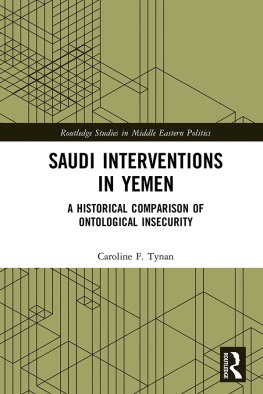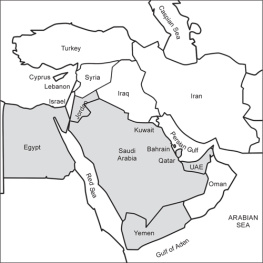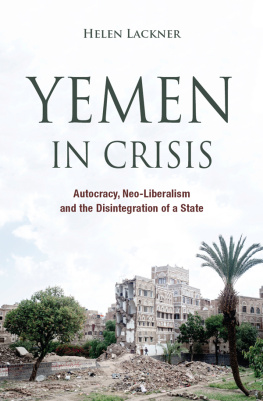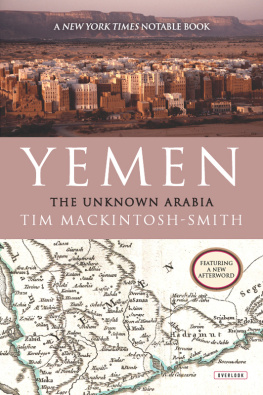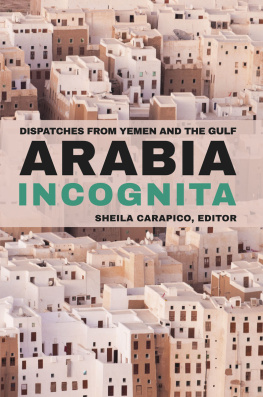Uzi Rabi is Director of the Moshe Dayan Center for Middle Eastern Studies at Tel Aviv University. He is the author of The Emergence of States in a Tribal Society: Oman Under Said bin Taymur, 19321970 (2006), and the editor of International Intervention in Local Conflicts: Crisis Management and Conflict Resolution Since the Cold War (I.B.Tauris, 2010).
Published in 2015 by I.B.Tauris & Co Ltd
6 Salem Road, London W2 4BU
175 Fifth Avenue, New York NY 10010
www.ibtauris.com
Distributed in the United States and Canada
Exclusively by Palgrave Macmillan
175 Fifth Avenue, New York NY 10010
Copyright 2015 Uzi Rabi
The right of Uzi Rabi to be identified as the author of this work has been asserted by the author in accordance with the Copyright, Designs and Patent Act 1988.
All rights reserved. Except for brief quotations in a review, this book, or any part thereof, may not be reproduced, stored in or introduced into a retrieval system, or transmitted, in any form or by any means, electronic, mechanical, photocopying, recording or otherwise, without the prior written permission of the publisher.
References to websites were correct at the time of writing.
Library of Modern Middle East Studies 160
ISBN 978 1 78076 946 2
eISBN 978 0 85773 771 7
A full CIP record for this book is available from the British Library
A full CIP record for this book is available from the Library of Congress
Library of Congress catalog card: available
Typeset by Newgen Publishers, Chennai
LIST OF MAPS
ACKNOWLEDGEMENTS
This book has been completed with deep sorrow, with the passing of my dear colleague, Joseph Kostiner. Joseph Kostiner, one of the worlds leading scholars in his field of expertise, was a central pillar in teaching and research on the Gulf and the Arabian Peninsula. He was a true gentleman, a very sensitive man and an admirable person, loved by his colleagues and students alike. I am indebted to him for having led me through the dynamics of states and societies in the Arabian Peninsula and the Persian Gulf. His wise comments and useful insights were instrumental to the completion of this book. Needless to say, any errors that remain are my own.
I also valued my conversations on Yemen with my colleagues from the Gulf and Yemen. I honor their requests for anonymity but wish to thank them for providing me their insights and for their generosity and helping me to understand the complex social and historical structures of Yemen.
Thanks are due to Rachel Kanz for her fine translation from the Hebrew. Special thanks go to my research assistants Chelsi Mueller, Brian Albert and Jordan Sokolic, who provided editorial assistance. Last but certainly not least, I owe my gratitude to my wife, Aviva and to our daughter and son, Gali and Guy, who have supported and inspired me throughout the research and writing of this book.
ABBREVIATIONS
AQAP | Al-Qaida in the Arabian Peninsula |
ATUC | Aden Trade Union Congress |
FLOSY | Front for the Liberation of Occupied Southern Yemen |
GCC | Gulf Cooperation Council |
GPC | General Peoples Congress |
JMP | Joint Meeting Parties |
NDF | National Democratic Front |
NLF | National Liberation Front |
SNACC | Supreme National Anti-Corruption Committee |
YSP | The Yemeni Socialist Party |
A NOTE ON TRANSLITERATION
Diacritical marks for long vowels have been left out; the ta marbuta is not shown; the shadda is indicated by doubling the consonant containing it; both the dal and the dhad are transliterated with a d and the dhal is transliterated with a dh. I also used the common English of the names of known individuals and countries, as well as words that have gained common usage in English. For example, Gamal Abd al-Nasser instead of Nasir, Sanaa instead of Sana and mujahideen instead of mujahidin. The plural of transliterated terms is formed with an -s.
PREFACE
Although Yemens history is unique, it has been relegated to the sidelines of research on the modern history of the Arab Middle East. Yemen, located in the south-western corner of the Arabian Peninsula, has been far from the purview of regional and international attention. The aim of this book is to expose the reader to the history of Yemen in the modern era and provide some insights into the dynamics of state and society in Yemen throughout the twentieth century.
In its glorious past, Yemen served as a crossroads for the great civilizations in Egypt, Mesopotamia, East Africa, the Indian sub continent and the Far East. Valuable goods were exported from Yemens south, in particular aromatics such as frankincense and myrrh. This civilization reached its zenith under the kingdoms of Saba and Himyar, which developed in the territorial region of Yaman, a region smaller The incense trade route served as the basis for the emergence of trade in the kingdoms of Saba and Himyar. These kingdoms played a pivotal role as transition points in the trade routes between the Middle East and India. Through their control over the trade route for valuable goods, these kingdoms flourished, and the entire region was known as Arabia Felix (al-Arabiyya al-Saida) in ancient times. The disappearance of these trade kingdoms marked the decline of Yamans greatness. The impressive archaeological remnants that were left behind testify to the story of a glorious civilization.
With the emergence of Islam, Yemen became an inseparable part of the Muslim world. Beginning in the tenth century, the territory became detached from the large Islamic empires and was ruled by various dynasties. In the early sixteenth century, Yemen fell to foreign occupiers and domination, beginning with the Dutch and Portuguese and followed by the Ottomans. Later in the nineteenth century, Yemens territory was further divided by the Ottomans and the British.
Throughout history, Yemen was rarely ruled as a single entity. The topography of the country rendered this a complicated mission. The scanty base of resources and limited economic surpluses made the establishment of strong and efficient central rule a formidable task. Moreover, the societys religious characteristics a Shii Zaydi population in the northern highlands and Sunni Shafii populations in the south and south-west complicated the development of an ideological and legitimate basis from which to rule the entire country. Above all, Yemen remained a predominantly tribal society, which is perhaps one of the countrys most influential legacies.
Yemen witnessed two Ottoman occupations. The Ottomans ruled the Arabic-speaking lands of the Middle East, including Yemen, beginning in the second decade of the sixteenth century. The first period of Ottoman rule in Yemen lasted from 1539 until 1636. The Ottomans returned in 1849, this time in the north of the country. Just ten years earlier the British had established a foothold in the south of the country, turning Aden into their port and colony. Throughout the nineteenth century, the British and the Ottomans divided the country into two spheres of influence.
With the waning of Ottoman power, the Zaydi Imamate began to entrench its control in the north of the country, and under the leadership of the Hamid al-Din dynasty, it re-staked its claim over Yemen. Imam Yahya bin Husayn bin Muhammad (r. 19051948) demonstrated an impressive ability to unite the country under his rule, whereas geographical conditions had caused many of his predecessors to fail. Though in his career Yahya would bring large areas of north Yemen under his control, the south remained under British control despite his moral claim to rule all of Yemen. Throughout his reign, Yahya zealously maintained divisive policies and administered his state according to tribal patterns, but he nevertheless ensured his states relative stability. This strategy ran its course during the rule of his son Ahmad, as Yemen was exposed to the winds of change from the outside world and the forces of reform from within.
Next page


